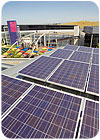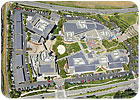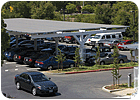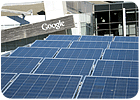
The 1.6-megawatt cool roof system is designed to feed into Google’s overall operations, reducing the amount of electricity the company purchases from its local utility by 30 percent.
One green corporation’s search for an environmentally friendly roofing system is complete after Sharp provided roof-mounted solar modules for the nation’s largest commercial solar electricity system at Google’s headquarters in Mountain View, Calif.
Joe Benga, executive vice president of project engineering and construction for EI Solutions in San Rafael, Calif., which acted as the project’s general contractor, said the Google system also features a structure that covers two carports where employees can park and recharge their plug-in hybrids.
"The installation will result in a 30 percent reduction of their estimated energy demands," Benga says. "It moves Google further up to be a green corporation. It features not only solar but other green initiatives. Right now, the solar modules will take care of 30 percent of their demands."
According to Ron Kenedi, vice president of Sharp’s Solar Energy Solutions Group, Sharp shares Google’s goal to create and expand environmentally friendly technologies. With this system, Google is setting an example for other corporations as to the tremendous environmental and financial benefits of solar energy," Kenedi says. "But even more so, Google is demonstrating that solar electricity is just like regular electricity, and it can power anything from computers and copiers to servers and hybrid electric cars."
Google’s corporate commitment to the environment is part of the company’s culture. According to the company’s Web site, Google strives to inspire its employees to be conscious of their impact on the environment. "We embrace hybrid technology, biking to work, and the use of shuttles and carpools," the Google Web site says, noting the solar panel installation at its headquarters is one of the largest on any corporate site in the world. "This direct installation of clean and renewable power was the first step in reducing our environmental impact as a company."

One corporation’s search for an environmentally friendly roofing system is complete after Sharp provided roof-mounted solar modules for the nation’s largest commercial solar electricity system on the campus of Google’s headquarters in Mountain View, Calif.
Construction Phase
The construction phase of Google’s solar-power roof was the easy part, according to Benga. "There’s nothing unusual about the installation. It was straightforward construction," he says. "But what we are amazed about is how much interest this project has generated. We’re amazed how many other corporations want to see this project and talk about it."Sharp, which assembles a variety of panels for residential and commercial installations, provided 9,212 of the company’s 208-watt solar modules for the Google project. The 1.6-megawatt system is designed to feed into Google’s overall operations, reducing the amount of electricity the company purchases from its local utility.
"The panels take up around 200,000 square feet," Benga says. "We used every available roof space that made sense. You might have a flat roof, but we looked at shading areas. It doesn’t make sense to put it there [in the shade]. We had multiple roofs, pitches. We made sure it maximized output of solar panels."
Benga says the system utilized nearly all of the available roof space at Google’s headquarters using mounting equipment from UniRac. "A UniRac system provided for standing seam and carport structure," he says. "The solar panels on flat portions of built-up roof sections used a funneling system. We mounted solar panels on these UniRacs."
Work on the site began on Nov. 18, 2006, and concluded on April 19, 2007. "We designed and installed the project," Benga says. "Blue Oak Engineering of Davis (Calif.) handled the engineering design; Bigham Taylor Roofing out of Hayward (Calif.) handled the roofing; and Cupertino Electric handled the electrical, panel installations on the roof."
"Cupertino did a lot of pre-assembly," Benga points out. "We mounted UniRacs in and loaded them on flatbed trucks and had them trucked in. Then we craned them up on the roof and set them in place."

Solar panels were attached to the roof of carports at Google’s corporate headquarters.
A Unique Installation
There were scheduling concerns to deal with during the construction phase, which included more than 1,000 hours of crane use. "The construction portion was not difficult, but Google’s campus works almost 24 hours a day," Benga says. "We didn’t interfere with their operations. Crane picks were done early in the morning. We were conscious of noise when working on the roofs.""We knew we couldn’t shut down their system. That’s why it had to be coordinated long in advance," he continues. "They shut down for about two hours: first time they ever had a plant shut down. They had backup systems, but generally it had to be planned out months in advance. Google was cooperative, an excellent customer to work with."
Safety was a paramount consideration. "We adhered to California OSHA and conducted weekly safety meetings to discuss any safety concerns," Benga says. "We did not lose anyone. No injuries during construction."
Matt LeDucq, project manager for EI Solutions, was the on-site construction manager for the Google project. "Schedule, quality and safety were my top concerns," LeDucq says. "We used a lot of communication, and an unusually dry winter in California helped us close the project by allowing us to work more days. We missed just two days work because of rain, and we used a lot of off-hours work, graveyard and swing shifts."
LeDucq notes the standing seam roof at Google headquarters is pitched at 8 degrees, resulting in safety issues. "We had to do a lot of fall protection programs," he says. "The roof was twisted, like taking a ribbon or piece of paper and twisting it. It made installation in those conditions unique. It was new to everyone on the job. Nobody had done a roof like this before."

Sharp, which assembles a variety of panels for residential and commercial installations, provided 9,212 of the company’s 208-watt solar modules for the Google project.
The Solar Panels
Sharp’s Solar Energy Solutions Group is a unit of Sharp Electronics Corp., the U.S. subsidiary of Sharp Corp., Osaka, Japan. Sharp offers both standard and integrated roof modules for residential and commercial applications."Sharp stepped up," Benga states. "They met our schedule at the right price point and delivered these panels. It was nice to have no moving parts."
Sharp also maintains solar panel assembly operations at its manufacturing facility in Memphis, Tenn. The solar manufacturing facility assembles a variety of panels for residential and commercial installations.
"We’re in this business because we want to make a difference," Benga says. "We’re extremely excited that Google let us show them what we can do."
LeDucq compared the completion of Google’s solar roof to a holiday dinner. "After you cook Thanksgiving dinner, you really don’t want to eat it anymore," he says. "I can say this project was the single most dynamic and complex project I’ve ever been involved with."
Report Abusive Comment